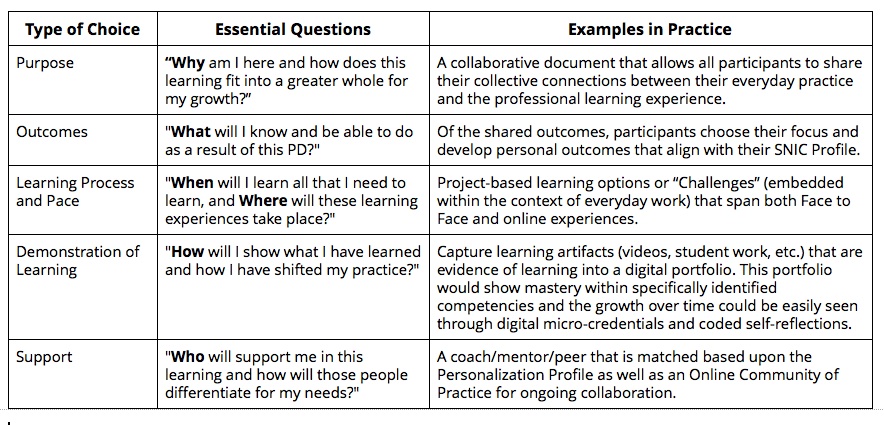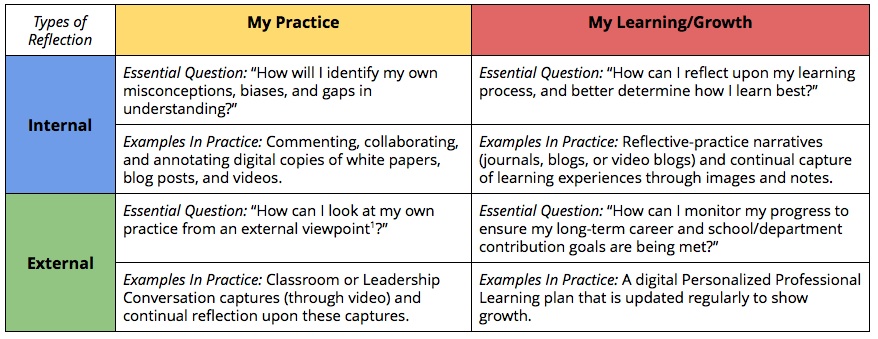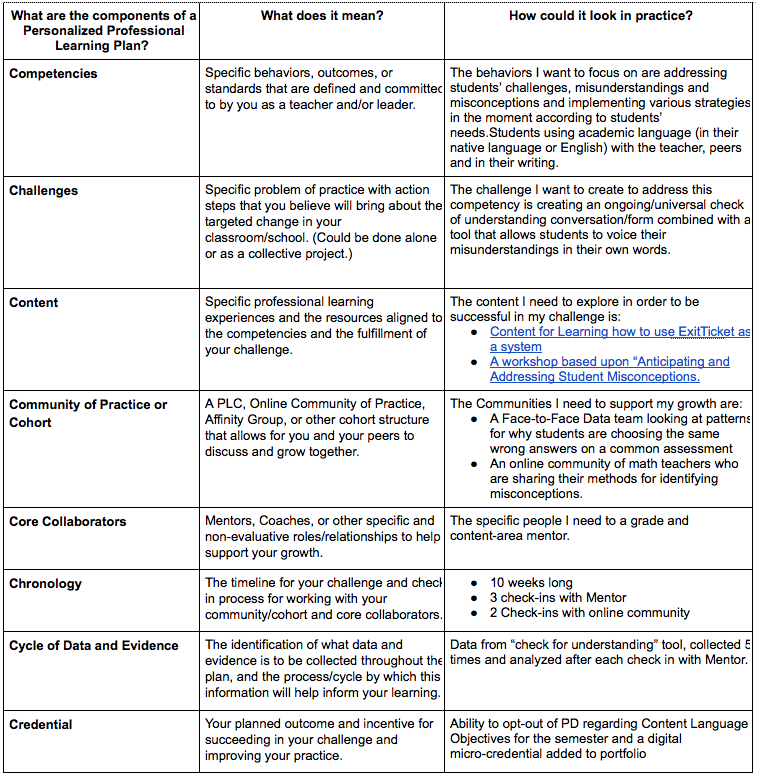Last week, we shared the first part of a two part series on Personalized Professional Learning. Ben Wilkoff dives deeper into how teachers can engage in their learning once they’ve identified the strengths, needs, interests and constraints have been identified.
By starting with the whole “Person” and determining the Strengths, Needs, Interests and Constraints (SNIC), the learning can be fully owned by the learner. This “Personalization Profile” is an entry point for professional learning, but in order to fully support the learner, we must consider the ways teachers and leaders engage in professional learning through their Choice, Transparency, and Reflection. These are the three pillars of Professionalized Professional Learning, and it is by understanding them that we can start to build a system that supports the growth of all of our teachers and leaders.
Choice
Choice in learning is neither solely “tight” (made by those at the district or CMO level) nor solely “loose” (made by the individual). Rather, it is a series of interconnected selections to fully meet the needs of both the learner and the system in which the learner exists. It is through choice that the learner first understands the external controls upon their learning and how and where they are empowered to fully take advantage and ownership of their learning opportunity. The chart below outlines the different types of choices available within a given Professional Learning system. It is up to the different roles within that system to determine which choices are owned at which level (individual, school, district). It is our belief that the more choices that are owned by the individual, the more personalized the Professional Learning can become.

Transparency
Personalized does not mean isolated, rather it is rather through the transparency that the most valuable personalized connections of all are made. By “learning out loud”, an adult learner can connect with others who are learning alongside or who can challenge and support the learner because they have heard the needs of that individual. Professional Learning cannot be done in a vacuum. It must be connected to the growth of the individual across time and space, gaining insight from others because of the transparent and transferable nature of the skills being learned. Personalized Professional Learning experiences focus on learning in context. The context is specific to the individual and the system within which the individual sits. By making the context and the choices within that context transparent, an adult learner has both the autonomy to learn in ways that accelerate growth and the coherence necessary to navigate the learning system.

Reflection
The goal of all professional learning is to create a change in practice. Self-reflection is the key metric of that change, and is documented as a part of a rigorous questioning process. It is not simply asking about what you can “stop, start, and keep doing.” Rather, the reflection process is focused upon looking deeply at the teaching/leading practice from multiple lenses and determining how to extract next steps. As the evidence of reflective practice compounds, the individual learner (and the system/school they exist within) will show growth over time. This growth and the next steps necessary to make that growth is specific to the individual, and form the foundation for a personalized professional learning plan.

It is through the core elements of Choice, Transparency, and Reflection that we start to see the framework for Personalized Professional Learning come into focus. But, this is only the beginning. In Denver Public Schools, we are trying to utilize this framework to help create better professional learning, but there are a lot of assumptions that we are making in staking the claim that all teachers and leaders should have access to this type of professional learning. Just as the framework is an important tool for creating professional learning, understanding the assumptions is essential to understand the context from within which we have created this framework.
These assumptions include:
- All adult learners deserve a face-to-face and online network/community of support, ideally with a mentor or coach, guiding the way.
- All adults learners should be trusted as agents in the creation of their own Personalized Professional Learning Plans or paths.
- All professional learning should be built for the individual Strengths, Needs, Interests, and Constraints of the adult learner, constructing an actionable profile for growth for each person.
- All adult learners exist within a system (the school and/or the district). There should be a clear process for making professional learning decisions that respect both the learner and the system.
- All data and learning products created by learners should be owned by them and transferable to their choices of systems.
One of these core assumptions deals with how we make plans within a Personalized Professional Learning system. This aspect of planning is the concrete outcome from having a robust framework, so it needs further attention if the system is going to support learners fully.
We make learning plans all of the time. Whenever we want to know something or learn how to do something new, we commit ourselves to a plan of action. It is this type of natural and authentic planning that we would like to build upon, as these have a high rate of success. Other types of plans that do not require personal investment, are doomed to fail. What we have attempted to do here is to identify all of the components of the plan that requires the individual to co-own the process, rather than relying solely on the system. Some components can be extremely lightweight, only requiring a single person or structure to be identified. Other components may require more extensive development and to be supported more fully by others. Our purpose here, though, is to build a plan that is adaptive enough to meet the needs of all adult learners.

When we combine this type of planning with a strong Professional Learning Profile and structures that support choice, transparency and reflection, we end up with a system that focuses on the people first, then the processes, and then the plan. It is that order that allows for a system to flourish. When you start with the plan first, the people get weighed down by all of the requirements. When you start with the process first, you end up spinning your wheels for lack of a plan to implement. We are choosing to put our people first, and building the system around them. We believe this is the way forward for our district in specific and for professional learning in general.
We fully recognize, however, that this is placing a rather large bet that this version of Personalized Professional Learning will lead to better outcomes for both students and teachers. We are betting that that teachers will find more satisfaction in their work and stay longer within a teaching or leadership role. We are also betting that you are trying to do some of the same things where you are. In an effort to make good on the promise of Transparency outlined above, we wanted to share our thinking and get feedback.
So, we have set up a form to do just that. If you are interested in continuing this conversation or in providing feedback on this model, please fill it out. Thank you!


